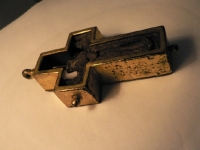



Mehr denn je gefragt Granat von Perpignan Die heutige Herstellung konnte trotz der Beibehaltung herkömmlicher Techniken ein neues Design entwickeln. Die Rückkehr zur geschlossenen Fassung wird zwei Anforderungen gerecht: dem aktuellen Kundengeschmack und der traditionellen katalanischen Arbeitsweise. Es entwickeln sich indessen zwei Schulen: die eine fertigt von Hand gemachte Unikate, die andere arbeitet mit Designern, die sich neuester Technik bedienen. Zwei Richtungen also, die ein völlig unterschiedliches Schmuckverständnis aufweisen. … Continuer la lecture
Meisterwerke des Kunsthandwerks Die Zeit zwischen den Kriegen bringt die Herstellung von Granatschmuck zu neuer Blüte, die sich der stilistischen Annäherung zum Art Déco verdankt. Die Zahl der Schmuckschaffenden ist bedeutend und man findet sie verteilt im ganzen Departement der Pyrénées Orientales. Ausser den grossen Bijouterien wie Velzy oder Charpentier trifft man in Prades auf eine Blüte, die durch Joseph Calvet begründet wird, der 1921 die Erbin der hundertjährigen Bijouterie … Continuer la lecture
Biszchofskreuze und Marienkronen Die katholische Kirche, die nach 1900 überaus aktiv war im Regionalismus, hatte ihrerseits auch ein Interesse an diesem Stein, der zum Symbol für ein Volk geworden war. Eines Volkes, das einst romanische Klöster errichtet hatte und einer katalanischen Kultur, die immer ihren tiefen Glauben zur Schau getragen hatte. Einige Kelche werden mit Granaten geschmückt; wie der, den Paul Soulié für seinen Sohn bestimmte , der 1905 in … Continuer la lecture
The Garnet at the crossroads of different aspirations After the Second World War, Roussillon becomes one of the laboratories a new consumer society eager for holidays in the sun. Beginning in 1963, the Racine mission launched an unprecedented project to develop the coastal region, in order to allow millions of vacationers to stay on home soil, doubling the summer population of the Pyrénées-Orientales. An influx of tourists spread out … Continuer la lecture
Regionalism Since the last years of the 19th century, regionalism has played a large role in artistic creativity in Roussillon, a period of prosperity worthy of the Belle Epoque, during which time there was no desire to lose the connection with the roots of Catalan art. The garnet becomes central to a carefully orchestrated debate between the concepts of progress and tradition, and has become an emblem of “Catalan identity”, … Continuer la lecture
Without neglecting traditional methods of production, the Perpignan garnet today has been able to adjust to new designs. The return of the raised closed setting managed to satisfy two principles: the current tastes of the client, and respect for Catalan traditional techniques. However two schools have emerged: creation of a unique handmade piece, and that of the stylist which makes used of the latest techniques. There are two very different … Continuer la lecture
Powerful and active after 1900 in an environment of regionalism, the Catholic Church also turned its interest to this gem, now a symbol of a people who once had built the Romanesque Abbeys and a Catalan culture always demonstrative in its lively faith. Some chalices were adorned with garnets such as the one Paul Soulié willed to his son, ordained as a priest in the Cathedral of Perpignan in 1905. … Continuer la lecture
In the inter-war period gave garnet jewelry a new impulse thanks to its capacity to adapt to the Art deco style. The number of jewellers is significant and covers most of the area of the Pyrénées-Orientales. Behond the great jewellery houses, such as Velzy or Charpentier of Perpignan, Prades is notable for its revival under Joseph Calvet, who married the heiress of a century-old Quès jewellery house, , in 1921. … Continuer la lecture
Turning gold into wire In Perpignan gold is exclusively used for Garnet jewelry. Mined industrially near the village of Glorianes (Pyrénnées-Orientales) from the 1920s to the 1960s, Catalan gold has been used since time immemorial. Processed and worked into fine sheets or wire of different thicknesses, gold is first passed through a manual or an electric machine to refine the metal. In the nineteenth century Catalan jewellers were specialized in … Continuer la lecture
L’Art Nouveau européen ou l’affirmation des provinces Les vingt dernières années du XIXe s. sont un tournant dans l’art de la bijouterie par l’apparition d’un style touchant tous les domaines des arts décoratifs et liant les pays européens. Toutefois l’Art nouveau possède dans chaque pays ou microrégion des caractéristiques bien précises. Ses débuts sont fortement liés aux idées régionalistes. Chaque capitale régionale où provinciale voulait jouer un rôle centralisateur et contribua … Continuer la lecture